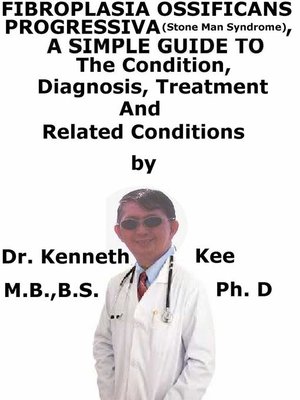Fibrodysplasia Ossifican Progressiva (Stone Man Syndrome), a Simple Guide to the Condition, Diagnosis, Treatment and Related Conditions
ebook
By Kenneth Kee

Sign up to save your library
With an OverDrive account, you can save your favorite libraries for at-a-glance information about availability. Find out more about OverDrive accounts.
Find this title in Libby, the library reading app by OverDrive.



Search for a digital library with this title
Title found at these libraries:
| Loading... |
This book describes Fibrodysplasia Ossifican Progressiva, Diagnosis and Treatment and Related Diseases
It is hard to believe that genetic mutations can produce abnormal human illnesses such as the Stone Man Syndrome or Werewolf Syndrome.
After reading about genetic diseases, I find that there are really such cases found in medical history.
Just like the X-men and Incredible Hulk genetic mutations can produce abnormal disorders such as Stone Man Syndrome and Werewolf Syndrome, even Mermaid Syndrome, Tree Man Syndrome and Harlequin Baby.
These are really amazing true genetic disorders.
In Stone Man Syndrome, muscle and connective tissue such as tendons and ligaments are slowly replaced by bone (ossified), producing bone outside the skeleton (extra-skeletal or heterotopic bone) that restricts movement.
There are no other known disorders in medicine of one normal organ system turning into another.
There are essential reasons why muscle is muscle and bone is bone.
Occasionally the patient requires flexibility and strength.
Other times the patient requires hardness and structure.
In this rare disorder called fibrodysplasia ossificans progressiva (FOP), this system is disrupted.
The body's soft tissues (muscles, ligaments, and tendons) transform into bone and form a second skeleton outside the normal one.
As the bone takes over, it becomes harder or even impossible to move different parts of the body, which affects everyday activities such as eating and talking.
In this disorder, there is the mutation of a gene in the bone morphogenetic protein (BMP) pathway, which is essential during the formation of the skeleton in the embryo and the repair of the skeleton after birth
The ACVR1 protein is present in many tissues of the body such as skeletal muscle and cartilage.
It is used to regulate the growth and development of the bones and muscles, such as the gradual replacement of cartilage by bone (ossification) that happens in normal skeletal maturation from birth to young adulthood.
Mutations in the ACVR1 gene disrupt the mechanisms that regulate the receptor's activity.
As a result, the receptor is activated when it normally should not be.
Too much receptor activity produces overgrowth of bone and cartilage, causing the signs and symptoms of fibrodysplasia ossificans progressiva.
FOP often begins in early childhood.
It starts around the shoulders and neck, then works its way down through the rest of the body.
Malformations of the toes and fingers may be evident at birth (congenital).
Abnormal development of extra-skeletal bone normally happens during early childhood.
In a few rare patients, the start of abnormal bone growth may not happen until late adolescence or early adulthood.
Affected patients may have periods of time where they are free of new events of bone growths.
The new bone growth can start at any time for no apparent cause (spontaneously).
In the affected regions, bone slowly replaces the connective tissue
Besides skeletal muscle, bony growths also happen in different tendons, ligaments, and bands of fibrous tissue that support muscles (fascia).
The neck, back, chest, arms, and legs are normally the first areas involved.
Abnormal development of bone finally causes stiffness and limited motion of affected joints.
If the jaw is affected, involved persons may have trouble eating and speaking.
As bone replaces tissue, the patient is unable to find the ability to move body parts making it harder to:
1. Breathe
2. Eat
3. Keep the balance
4. Speak
5. Walk or sit
FOP may ultimately cause...






